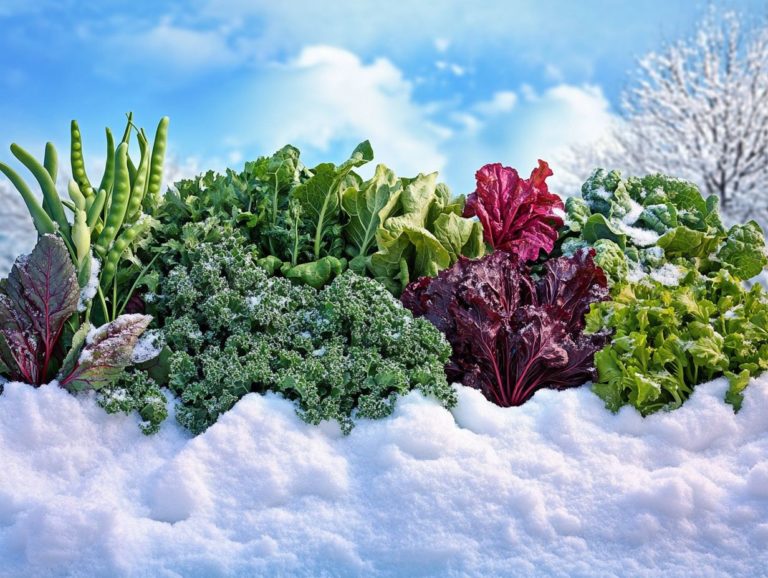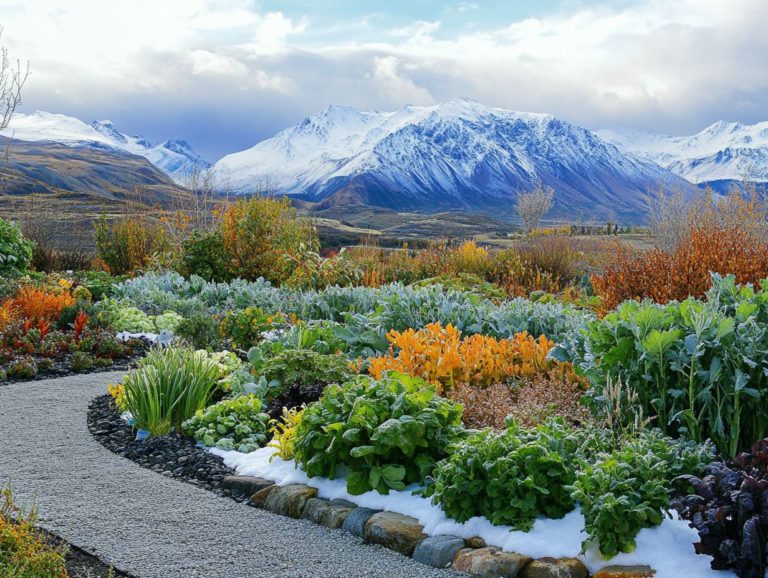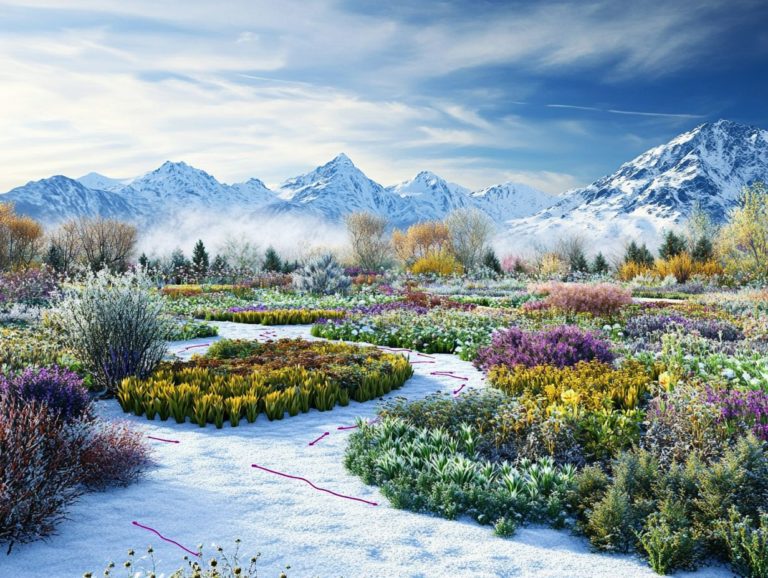Selecting Trees for Cold-Climate Landscaping
Landscaping in cold climates presents specific challenges and opportunities, especially when selecting the right trees. It’s crucial to know which species thrive and to understand their needs for a resilient and flourishing outdoor space.
This article explores the key factors to consider when choosing trees for colder environments, from evergreens to deciduous varieties. You’ll find best practices for planting, maintaining tree health, and additional insights to help your landscape thrive, even in chilly conditions.
Discover exciting ways to transform your cold-climate landscape into a stunning outdoor space!
Contents
- Key Takeaways:
- Understanding Cold-Climate Landscaping
- Types of Trees for Cold Climates
- Factors to Consider for Tree Health in Cold Climates
- Best Practices for Planting and Maintaining Trees in Cold Climates
- Additional Tips for Successful Cold-Climate Landscaping
- Frequently Asked Questions
- What should I consider when selecting trees for cold-climate landscaping?
- What are some examples of trees that are suitable for cold-climate landscaping?
- Do I need to consider the size of the tree when selecting for cold-climate landscaping?
- How can I make sure the trees I select for cold-climate landscaping will thrive?
- Can I use native trees for cold-climate landscaping?
- What are some common mistakes to avoid when selecting trees for cold-climate landscaping?
Key Takeaways:
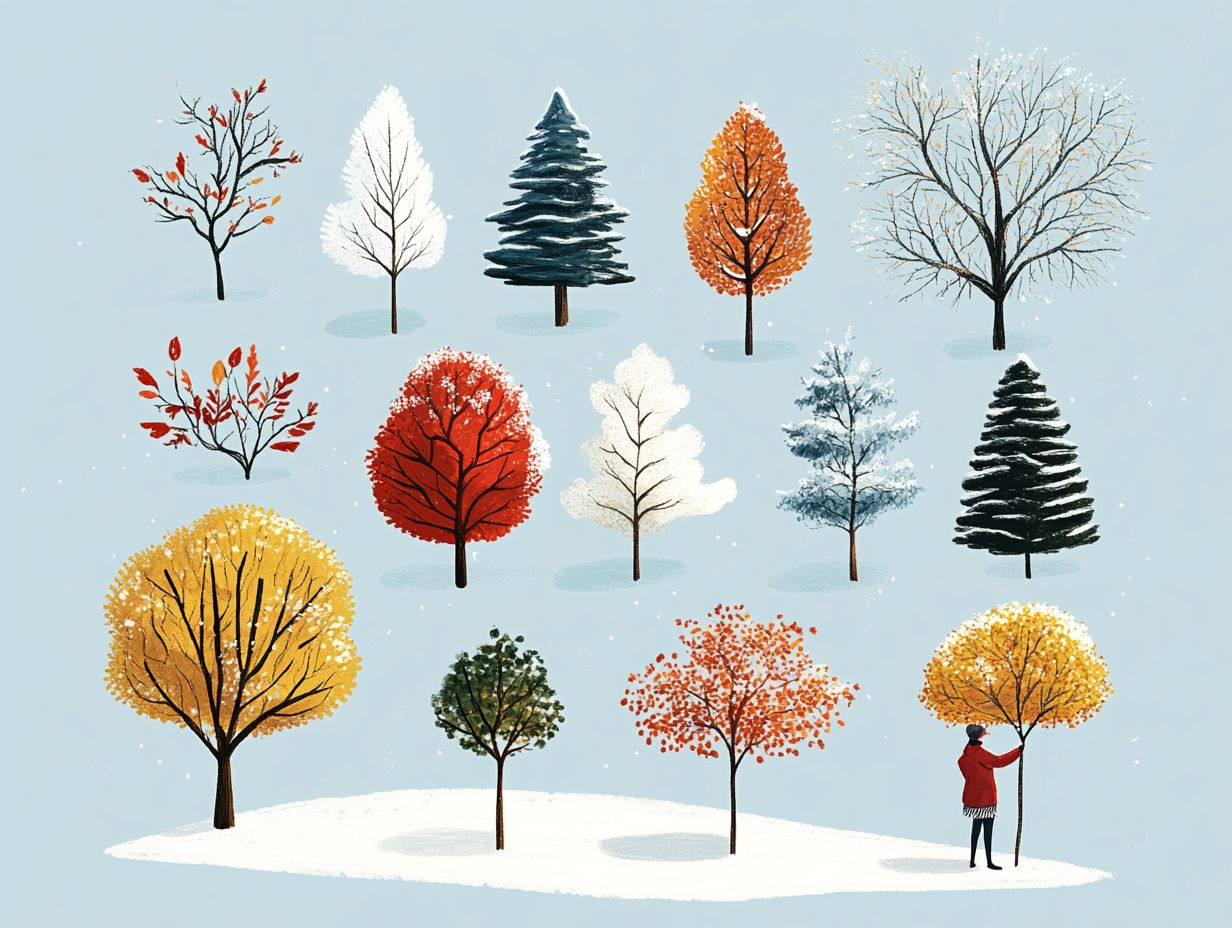
- Choosing the right trees in cold climates involves factors like winter hardiness, soil and moisture requirements, and tree type.
- Both evergreen and deciduous trees can flourish in cold climates, but they have unique characteristics and considerations.
- To ensure tree health, use proper planting techniques, regular pruning, and mulch for protection.
Understanding Cold-Climate Landscaping
Understanding cold-climate landscaping means exploring various factors that influence your tree selection, soil quality, and climate considerations, especially in places like Massachusetts. Here, the cold hardiness zone is vital for tree health and longevity.
As a homeowner, consider the unique characteristics of your landscape, such as soil composition and drainage. This knowledge elevates the visual appeal and seasonal beauty of your property while enhancing the ecological benefits by fostering biodiversity through native species.
Factors to Consider for Tree Selection
When selecting trees for cold climates, several critical factors come into play. Understanding plant selection for cold-climate design, including soil conditions, watering needs, maintenance requirements, and disease resistance, is essential for the longevity and health of your landscape.
-
First, understanding soil composition is key. It affects nutrient availability and drainage, influencing your trees root systems. Testing your soil for pH levels and organic matter content will guide your species choices.
-
Next, recognizing watering needs is vital. Some trees thrive in drier soils, while others require more moisture.
-
Maintenance is also crucial; certain species may need regular pruning to keep their shape, which can impact your time and resources.
-
Lastly, choosing disease-resistant trees, or those that can better fight off diseases, helps prevent harmful pathogens and keeps your landscape vibrant.
Types of Trees for Cold Climates
Many tree species thrive in cold climates. Understanding the differences between evergreens and deciduous trees can greatly enhance your landscape design, tree function, and overall beauty especially in harsh winter conditions.
Evergreen Trees
Evergreen trees, like Norway Spruce and Pine, add year-round elegance and are essential in colder landscapes. They provide shelter and sustenance for wildlife and require less winter preparation than deciduous species.
These trees have needle-like leaves, which help them maintain their lush, green appearance even during harsh winters. Ensure they receive regular watering, especially in dry periods, and occasional pruning to keep them thriving.
Be cautious; some species may be susceptible to pests like aphids or bark beetles, which can affect their health if not managed. Choosing well-suited varieties, such as Blue Spruce or Eastern Hemlock, helps them endure cold conditions and plays a vital role in soil stabilization and carbon absorption, enhancing both ecological balance and visual appeal.
Start planning your cold-climate garden today and watch it thrive all year round!
Deciduous Trees
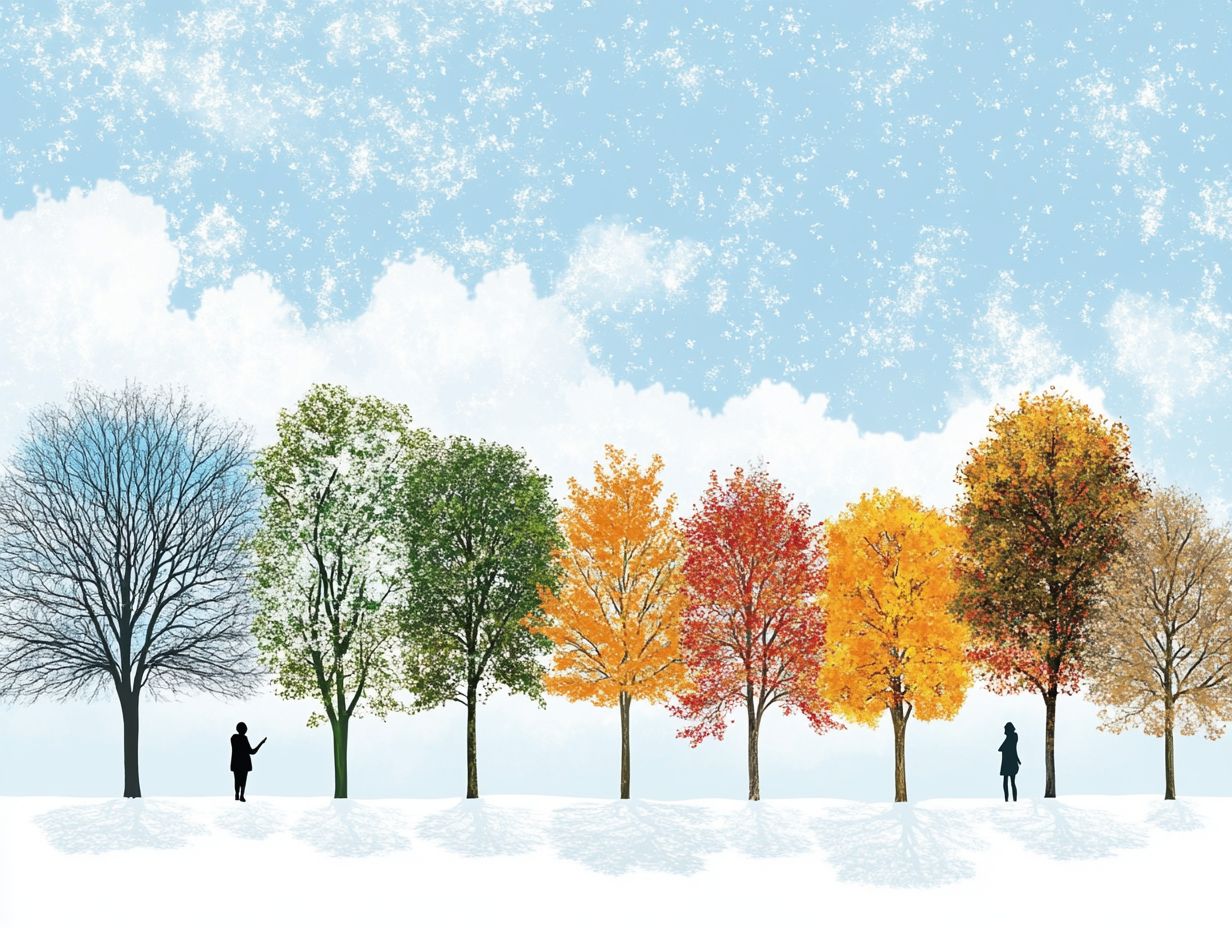
Deciduous trees, such as Maple and Oak, are celebrated for their breathtaking seasonal beauty. As they shed their leaves in winter, they enhance the landscape’s aesthetics and require attention to their pruning needs and cold hardiness to thrive.
These trees transition beautifully through the seasons, displaying vibrant foliage in spring and rich hues of red and gold in autumn. Their ability to create a visually dynamic environment makes them a premier choice for your landscaping projects.
When planting, select a species that aligns with your local climate and soil conditions. Regular maintenance like mulching, watering, and monitoring for pests is key for their longevity and health.
Beyond their stunning appearance, these trees provide invaluable benefits such as shade, wildlife habitat, and improved air quality, enriching the ecological value of your outdoor space.
Factors to Consider for Tree Health in Cold Climates
To keep your trees healthy in cold climates, understand several crucial factors. Consider winter hardiness, soil and moisture requirements, and how likely they are to get pests. These are essential for ensuring your trees thrive despite the harsh conditions.
Winter Hardiness
Winter hardiness is vital when selecting tree species in cold climates. It impacts their ability to endure freezing temperatures and maintain quality with minimal maintenance.
Choose native species, like the Eastern Redbud or the Sugar Maple, to enhance your landscape’s resilience. These trees not only survive harsh winters but also add aesthetic charm as the seasons change.
To assess a tree’s cold hardiness, consult the USDA Plant Hardiness Zone Map. This tool helps you choose the right plants based on your climate, ensuring your landscaping efforts succeed.
By incorporating winter-hardy trees, you support a sustainable environment that benefits local wildlife and reduces the need for protective measures during cold months.
Soil and Moisture Requirements
Understanding soil and moisture requirements is essential for tree health. Proper soil quality and drainage are crucial for ensuring trees receive the hydration and nutrients they need, especially in cold climates.
The relationship between soil composition and drainage influences the growth potential of various tree species. Finding the right balance of sand, silt, and clay can significantly affect water retention and drainage, impacting root development and nutrient uptake.
Evaluating soil conditions is vital. Conduct a simple drainage test to see how quickly water absorbs in your yard. Select tree species that align with your soil’s moisture levels some prefer well-drained soil, while others thrive in wetter conditions. Native trees often suit local soil types, making them ideal for supporting ecosystem health.
Best Practices for Planting and Maintaining Trees in Cold Climates
Implementing best practices for planting and maintaining trees in cold climates ensures their longevity and health. By using proper techniques, each tree can thrive, bringing seasonal interest and beauty to your landscape.
Routine care, including pruning and servicing, will enhance their well-being and vitality.
Proper Planting Techniques
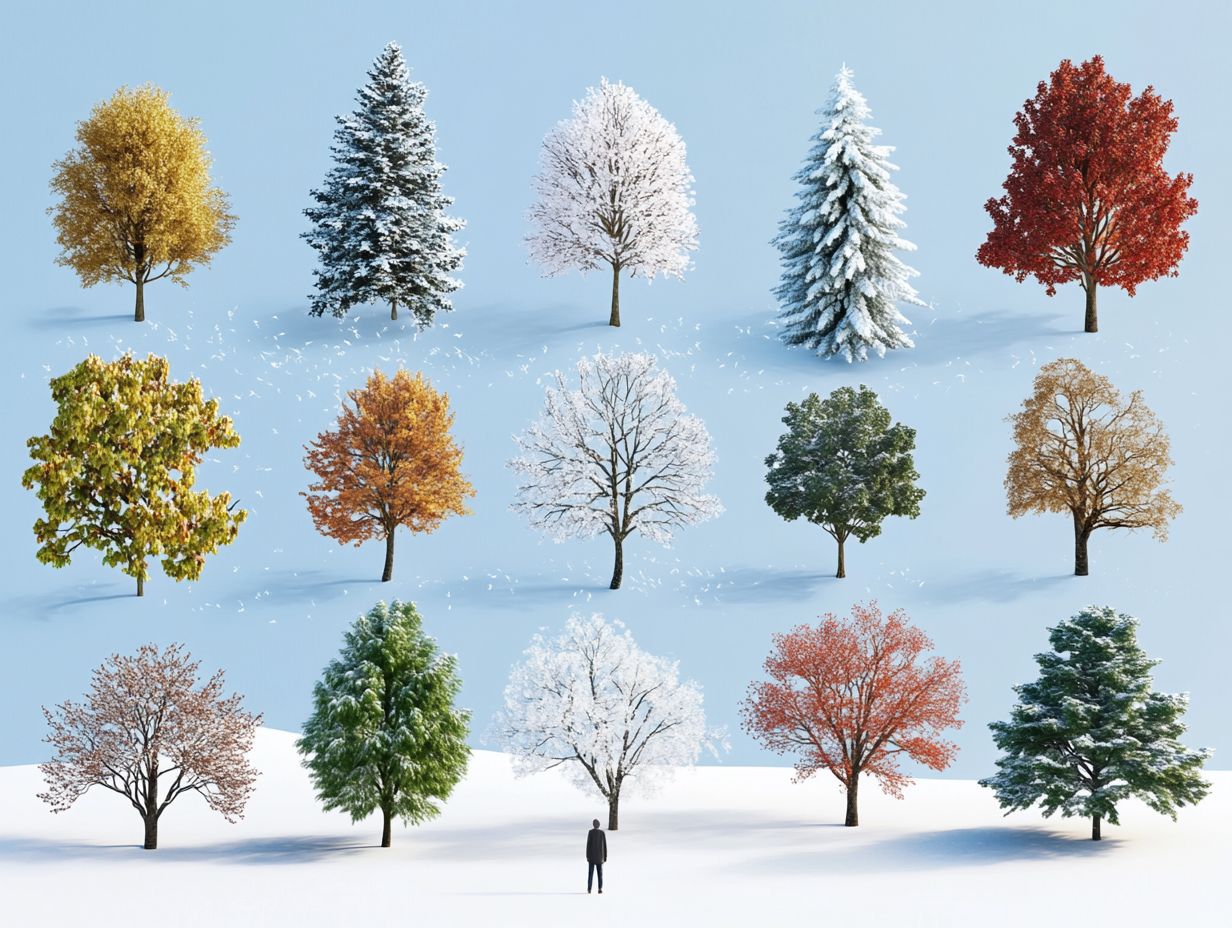
Proper planting techniques are crucial for ensuring the quality and health of your trees. Pay close attention to soil conditions, root spread (the area where the tree’s roots can grow), and the specific needs of each tree species all of which are vital for successful establishment.
Before you plant, take the time to assess the soil s texture, drainage capabilities, and nutrient levels. These factors significantly influence your tree s growth potential. After evaluating the soil, create a planting hole that accommodates ample root spread. This provides the roots with the space they need to grow and enhances the tree s ability to absorb water and nutrients effectively.
Incorporating organic matter into the soil offers additional support and improves overall soil structure. By following these techniques, you ensure the longevity of your trees and their contribution to a beautifully designed landscape, enhancing both aesthetic appeal and ecological balance.
Pruning and Maintenance Tips
Regular pruning and maintenance boost the beauty and health of your trees! This practice not only enhances aesthetics but also extends their longevity while reducing susceptibility to pests and diseases.
To achieve the best results, understand the optimal techniques and timing for pruning. For instance, many trees thrive when pruned in early spring, right before new growth begins, while certain flowering varieties do best when pruned immediately after blooming.
Using sharp, clean tools is critical to prevent damage and promote quick healing. Keep an eye out for dead or crossing branches, as these can lead to disease if left unchecked. If you re ever unsure, consulting a tree service professional can provide valuable insights, especially for larger trees or unique species, ensuring both safety and the vitality of your trees are preserved.
Additional Tips for Successful Cold-Climate Landscaping
Thriving in cold climates requires smart choices that make your landscape shine! Successful cold-climate landscaping involves much more than just choosing and maintaining trees; it encompasses a range of strategies, including the effective use of mulch, safeguarding your plants from wildlife, and applying seasonal landscape tips.
These elements work together to promote healthy growth and enhance visual appeal, ensuring your outdoor space thrives even in challenging conditions.
Using Mulch and Protection
Using mulch effectively in cold-climate landscaping not only enhances your soil quality but also helps retain moisture, protects tree roots from the biting cold, and contributes to the overall vitality of your landscape.
Mulch plays a pivotal role in regulating soil temperature, creating a more conducive environment for beneficial microorganisms and plant roots. By insulating the ground, it prevents drastic temperature fluctuations that can harm young trees and perennial plants.
When selecting mulch, it’s wise to choose organic materials like shredded bark or wood chips. These options not only break down over time but also improve the soil’s structure. For the best results, apply a layer of mulch approximately 2 to 4 inches thick around your trees and garden beds, while keeping it away from the plant stems to avoid rot and decay.
Frequently Asked Questions
What should I consider when selecting trees for cold-climate landscaping?
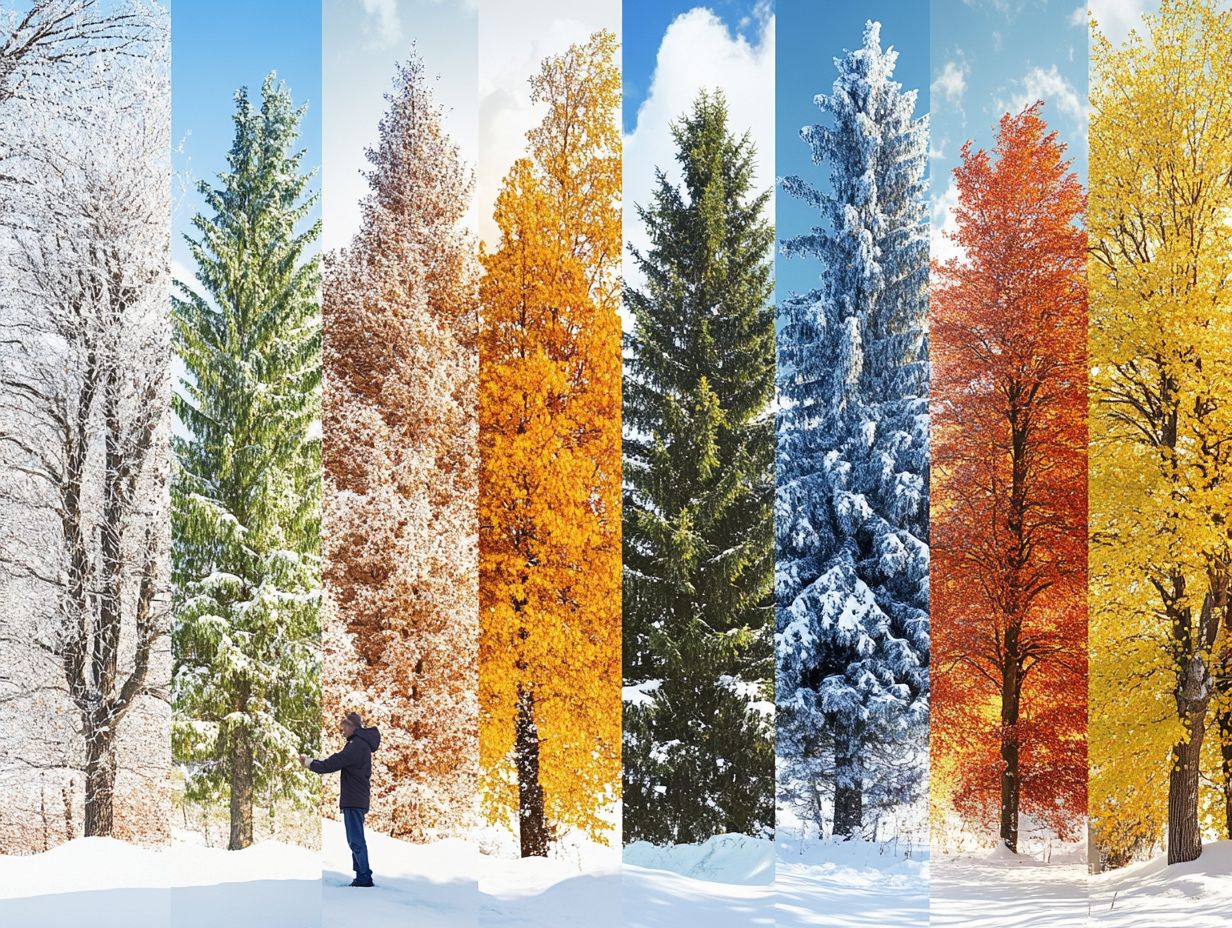
When selecting trees for cold-climate landscaping, consider how well plants survive in cold weather, soil conditions, and exposure to wind and snow. For optimal results, explore sustainable plant choices for cold climates. Trees that tolerate extreme temperatures, adapt to different soil types, and withstand harsh weather will thrive in a cold climate.
What are some examples of trees that are suitable for cold-climate landscaping?
Some examples of suitable trees include:
- Evergreens: spruce, pine, fir
- Deciduous: maple, oak, birch
These trees can withstand cold temperatures and have adapted to the specific conditions of a cold climate.
Start planning your perfect cold-climate landscape today!
Do I need to consider the size of the tree when selecting for cold-climate landscaping?
Yes, it is important to consider the size of the tree when selecting for cold-climate landscaping. Trees that are too large may be vulnerable to damage from strong winds and heavy snow. For optimal success, it’s crucial to know the best season for planting trees in cold areas, as smaller trees may struggle to survive in harsh conditions.
Choose trees that are the right size for your specific landscaping needs.
How can I make sure the trees I select for cold-climate landscaping will thrive?
To ensure that the trees you select thrive, research their specific care requirements. This includes proper planting techniques, watering and fertilization needs.
Also, consider pruning and maintenance. Choosing trees well-suited to your climate and meeting their individual needs will help them thrive in your landscape.
Can I use native trees for cold-climate landscaping?
Absolutely! Native trees are often well-adapted to the climate and soil conditions of your area. They make a great choice for cold-climate landscaping.
Native trees also support the local ecosystem and attract wildlife to your landscape. Be sure to research and select native trees suitable for your specific climate.
What are some common mistakes to avoid when selecting trees for cold-climate landscaping?
Some common mistakes to avoid include choosing trees that are not hardy enough for your climate zone. Selecting trees that are too large for your landscape is another pitfall.
It’s important not to overlook the tree’s individual care requirements. Avoid planting trees too close together, as this can lead to competition for resources and hinder their growth.
Don t risk your landscape! Avoid these common pitfalls to ensure your trees thrive.

